The AMD Radeon R9 Nano Review: The Power of Size
by Ryan Smith on September 10, 2015 8:00 AM ESTOverclocking
Finally, no review of a high-end video card would be complete without a look at overclocking performance.
Of all of the Fiji cards overclocking the R9 Nano is perhaps the easiest and certainly the most unusual. Due to the fact that the card is essentially a 1000MHz Fiji card with a heavy power throttle, the card is already validated for clockspeeds that under load it doesn’t have the available power to reach. As a result while one can crank up the clockspeeds, the card isn’t going to move until you increase the power limit. And even then you are more likely to hit the power cap again than you are to break 1000MHz sustained. So overclocking the GPU is something of an academic affair.
| Radeon R9 Fury/Nano Series Overclocking | |||||
| Ref. R9 Fury X | ASUS R9 Fury | Ref. R9 Nano | |||
| Boost Clock | 1125MHz | 1075MHz | 1075MHz | ||
| Memory Clock | 1Gbps (500MHz DDR) | 1.1Gbps (550MHz DDR) | 1.1Gbps (550MHz DDR) | ||
| Power Limit | 100% | 115% | 135% | ||
| Max Voltage | 1.212v | 1.169v | 1.2v | ||
Overall we were able to overclock our sample to 1075MHz on the GPU and 550MHz (1.1Gbps) on the memory. However load clockspeeds were almost always under 1000MHz even with a generous 35% increase in the power target. Overdrive does allow for a larger increase – up to 50% – but with the R9 Nano featuring a less robust power delivery system designed to push less power than R9 Fury or R9 Fury X, we’re hesitant to increase the limit further without a better idea of what the card can safely sustain for extended periods of time.
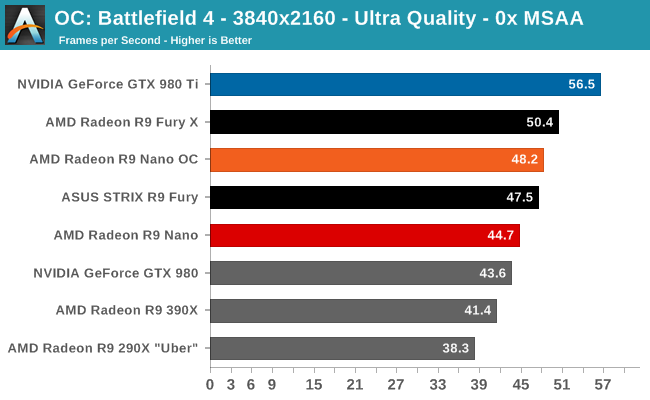

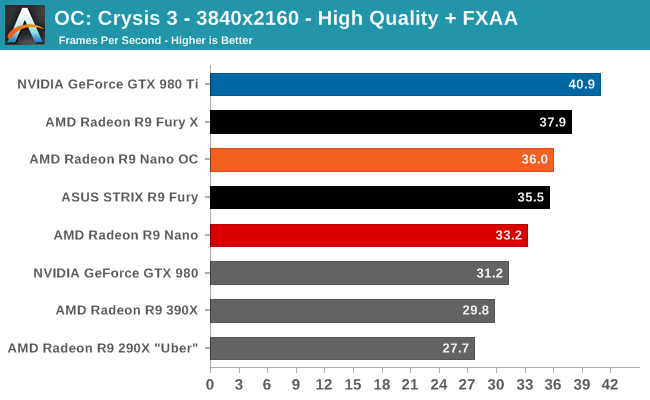
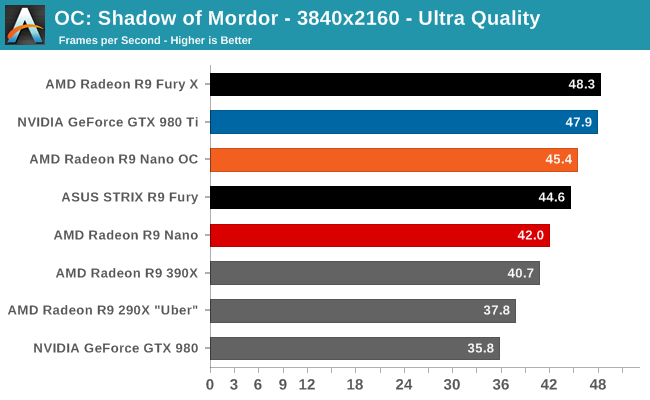
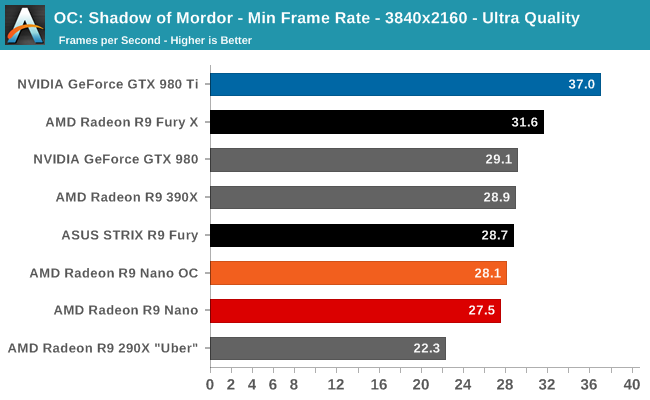
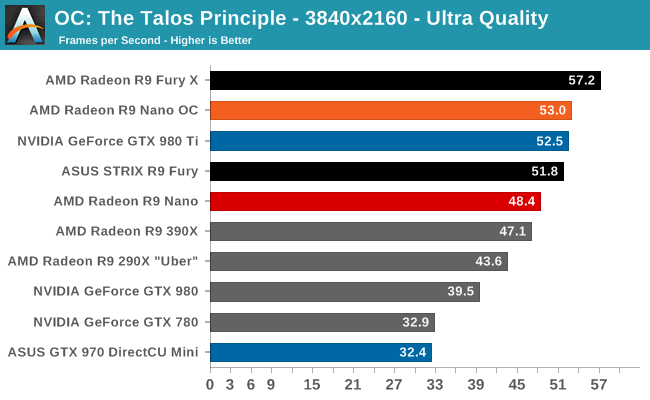
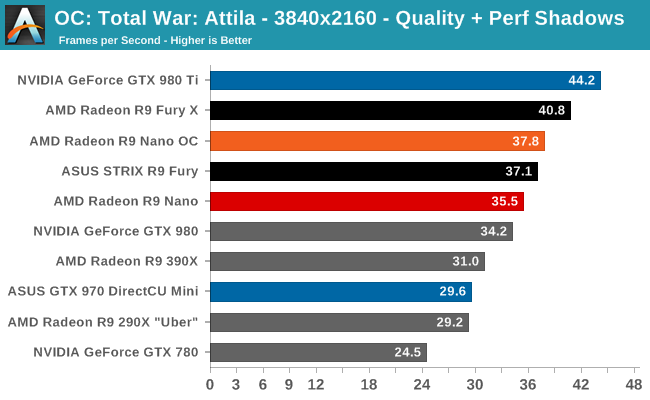
The overall performance gains from overclocking aren’t huge, but at 7-10% they also aren’t too shabby. However since higher clockspeeds quickly ramp up the power requirements due to the higher voltages required, the performance gains won’t be anywhere near the 35% increase in the power limit, despite that we are in fact still power limited.
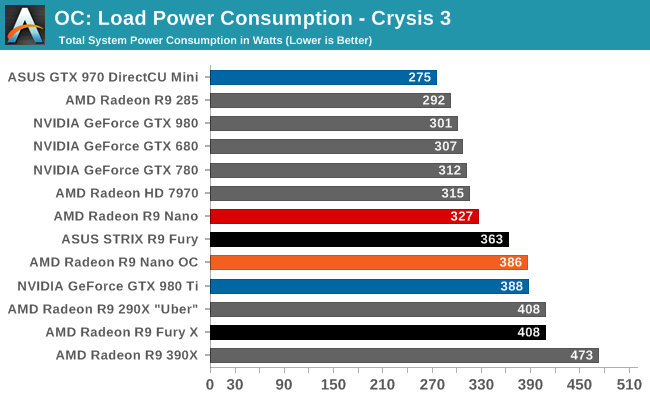
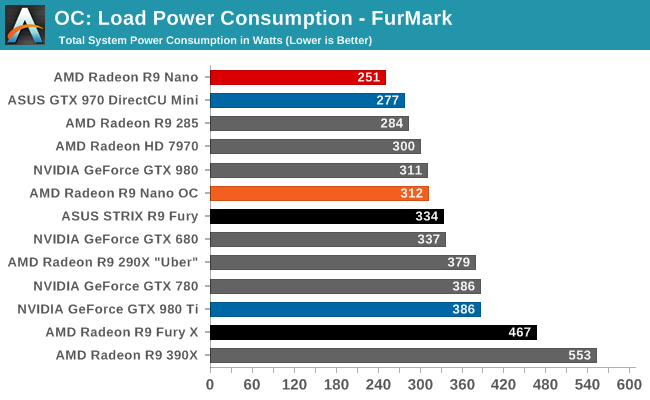
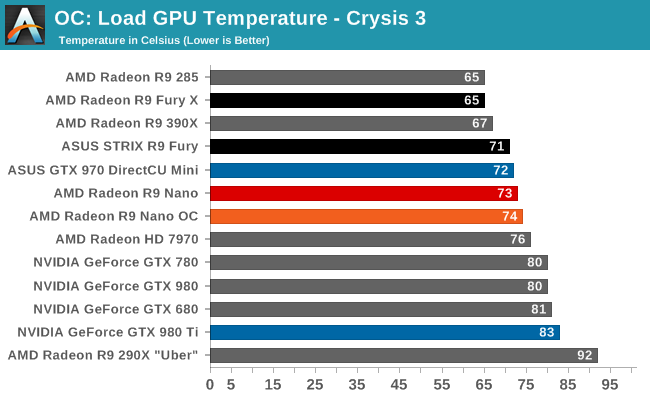
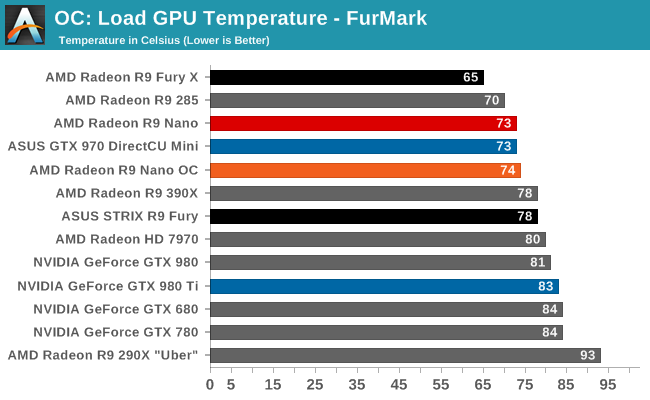
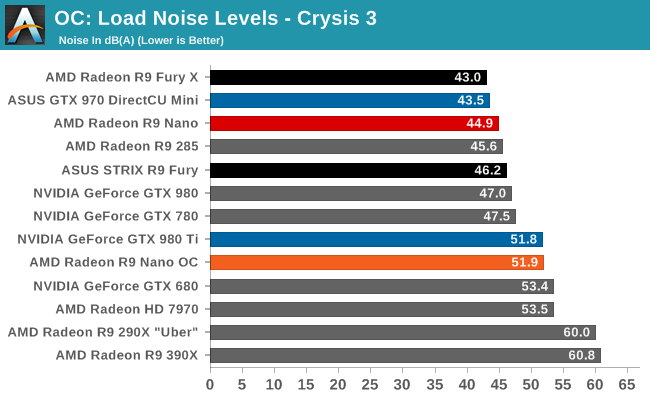
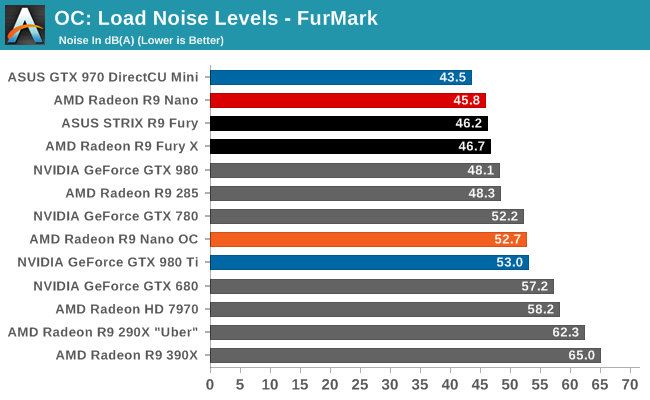
Meanwhile the 35% increase in the power limit has a definite knock-on effect on the cooling system. The R9 Nano’s cooler is able to keep up with the additional load, holding temperatures to 74C, but noise levels are now over 51dB(A). Power consumption at the wall is similarly affected, with the R9 Nano essentially giving up all of its energy efficiency gains in the process.










284 Comments
View All Comments
Oxford Guy - Tuesday, September 15, 2015 - link
I'll leave you to ponder this.Gunbuster - Thursday, September 10, 2015 - link
What a great little card for a miniature $3000+ boutique HTPC. Oh wait, no HDMI 2.0 for 4K.Asomething - Thursday, September 10, 2015 - link
you know you can add a passive dp-hdmi adapter right? its hard to find one that supports dp 1.2 but they exist. if $3000 plus an extra $30 is too much maybe dont make a $3000 HTPC.Gunbuster - Thursday, September 10, 2015 - link
Did you mean the fabled DP to HDMI 2.0 active converter that AMD keeps saying the channel will have "soon"Also once soon arrives we will have to see how well it actual works and if it introduces any input lag.
Fallen Kell - Thursday, September 10, 2015 - link
No, you can't buy a passive dp-hdmi adapter that supports proper HDMI 2.0+HDCP 2.2 that is needed for proper video content playback. These devices still do not exist. Parade Technologies has made an announcement on a chip/device to do this job, but they do not make end-user/consumer goods (think AMD/Nvidia when they do not make a reference card) and simply sell the chips to a vendor that makes the devices. They announced the product August 10th, 2015. It will be a good 4-6 months still before we see a vendor decide to make a product that uses that chip.ThomasS31 - Thursday, September 10, 2015 - link
So GTX980 Performance for GTX980Ti price... well.Some will probably interested in it... but this is "mispositioned" atm.
rhysiam - Thursday, September 10, 2015 - link
Kind of missing the point there I think. It's also slower and more expensive than a Fury (nonX), so if you don't want/need a small card then of course the Nano makes no sense whatsoever.The whole point of this card is it's size and (relative for AMD) efficiency, but naturally you need to either pay a little more or accept lower performance at the same price-point... that's the tradeoff.
TheinsanegamerN - Thursday, September 10, 2015 - link
but, if efficiency and size is a major selling point, why choose this over the 970 mini, which is half the price and uses less power?This makes the nano's market people who want a small mini itx card (so a HTPC case, as most itx gaming cases can take full size cards), which is efficient, but can't fathom buying an nvidia card, despite using less power while still performing well, and are willing to fork over 980ti levels of cash for 980 performance, to drive a 4k or 1440p displayport monitor (as there is no hdmi 2.0 on nano, so 4k tvs are out, and 1080p would favor the 970).
That's, like, a niche of a niche of a niche of a niche. Not really a major money making market for AMD.
przemo_li - Thursday, September 10, 2015 - link
But less performance too.I do not get why people get distracted with "energy efficiency" at all.
Its KING OF THE JUNGLE gpu. It's all about performance.
TheinsanegamerN - Thursday, September 10, 2015 - link
When you are building a small HTPC, which is the market AMD is aiming for with the nano, efficiency is very important. All that heat has to go SOMEWHERE. a lower consumption part won't produce as much heat. If you want a KING OF THE JUNGLE gpu, why are you looking at nano, and not titan x or fury x?